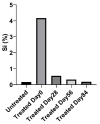Stability of SARS-CoV-2 on Commercial Aircraft Interior Surfaces with Implications for Effective Control Measures
- PMID: 37623181
- PMCID: PMC10454724
- DOI: 10.3390/ijerph20166598
Stability of SARS-CoV-2 on Commercial Aircraft Interior Surfaces with Implications for Effective Control Measures
Abstract
Background: The COVID-19 pandemic from 2019 to 2022 devastated many aspects of life and the economy, with the commercial aviation industry being no exception. One of the major concerns during the pandemic was the degree to which the internal aircraft environment contributed to virus transmission between humans and, in particular, the stability of SARS-CoV-2 on contact surfaces in the aircraft cabin interior.
Method: In this study, the stability of various major strains of SARS-CoV-2 on interior aircraft surfaces was evaluated using the TCID50 assessment.
Results: In contrast to terrestrial materials, SARS-CoV-2 was naturally less stable on common contact points in the aircraft interior, and, over a 4 h time period, there was a 90% reduction in culturable virus. Antiviral and surface coatings were extremely effective at mitigating the persistence of the virus on surfaces; however, their benefit was diminished by regular cleaning and were ineffective after 56 days of regular use and cleaning. Finally, successive strains of SARS-CoV-2 have not evolved to be more resilient to survival on aircraft surfaces.
Conclusions: We conclude that the mitigation strategies for SARS-CoV-2 on interior aircraft surfaces are more than sufficient, and epidemiological evidence over the past three years has not found that surface spread is a major route of transmission.
Keywords: SARS-CoV-2; fomite; transmission.
Conflict of interest statement
Authors John Ehret and Ian Hosegood were employed by the company Qantas Airways Ltd. The remaining authors declare that the research was conducted in the absence of any commercial or financial relationships that could be construed as a potential conflict of interest.
Figures






Similar articles
-
Increasing Temperature and Relative Humidity Accelerates Inactivation of SARS-CoV-2 on Surfaces.mSphere. 2020 Jul 1;5(4):e00441-20. doi: 10.1128/mSphere.00441-20. mSphere. 2020. PMID: 32611701 Free PMC article.
-
Detection of SARS-CoV-2 RNA in commercial passenger aircraft and cruise ship wastewater: a surveillance tool for assessing the presence of COVID-19 infected travellers.J Travel Med. 2020 Aug 20;27(5):taaa116. doi: 10.1093/jtm/taaa116. J Travel Med. 2020. PMID: 32662867 Free PMC article.
-
Evaluation of virucidal activity of residual quaternary ammonium-treated surfaces on SARS-CoV-2.Am J Infect Control. 2022 Mar;50(3):325-329. doi: 10.1016/j.ajic.2021.10.021. Epub 2021 Oct 29. Am J Infect Control. 2022. PMID: 34756967 Free PMC article.
-
Stability of SARS-CoV-2 on inanimate surfaces: A review.Microbiol Res. 2023 Jul;272:127388. doi: 10.1016/j.micres.2023.127388. Epub 2023 Apr 20. Microbiol Res. 2023. PMID: 37141851 Free PMC article. Review.
-
Stability of SARS-CoV-2 and other coronaviruses in the environment and on common touch surfaces and the influence of climatic conditions: A review.Transbound Emerg Dis. 2021 Mar;68(2):296-312. doi: 10.1111/tbed.13707. Epub 2020 Jul 14. Transbound Emerg Dis. 2021. PMID: 32603505 Free PMC article. Review.
References
-
- Hui D.S., Azhar E.I., Madani T.A., Ntoumi F., Kock R., Dar O., Ippolito G., McHugh T.D., Memish Z.A., Drosten C., et al. The continuing 2019-nCoV epidemic threat of novel coronaviruses to global health—The latest 2019 novel coronavirus outbreak in Wuhan, China. Int. J. Infect. Dis. 2020;91:264–266. doi: 10.1016/j.ijid.2020.01.009. - DOI - PMC - PubMed
-
- Derqui N., Koycheva A., Zhou J., Pillay T.D., Crone M.A., Hakki S., Fenn J., Kundu R., Varro R., Conibear E., et al. Risk factors and vectors for SARS-CoV-2 household transmission: A prospective, longitudinal cohort study. Lancet Microbe. 2023;4:e397–e408. doi: 10.1016/S2666-5247(23)00069-1. - DOI - PMC - PubMed
-
- Pena Rodriguez M., Hernandez Bello J., Vega Magana N., Viera Segura O., Garcia Chagollan M., Ceja Galvez H.R., Mora Mora J.C., Rentería Flores F.I., García González O.P., Muñoz Valle J.F. Prevalence of symptoms, comorbidities, and reinfections in individuals infected with Wild-Type SARS-CoV-2, Delta, or Omicron variants: A comparative study in western Mexico. Front. Public Health. 2023;11:1149795. doi: 10.3389/fpubh.2023.1149795. - DOI - PMC - PubMed
Publication types
MeSH terms
Grants and funding
LinkOut - more resources
Full Text Sources
Medical
Miscellaneous

